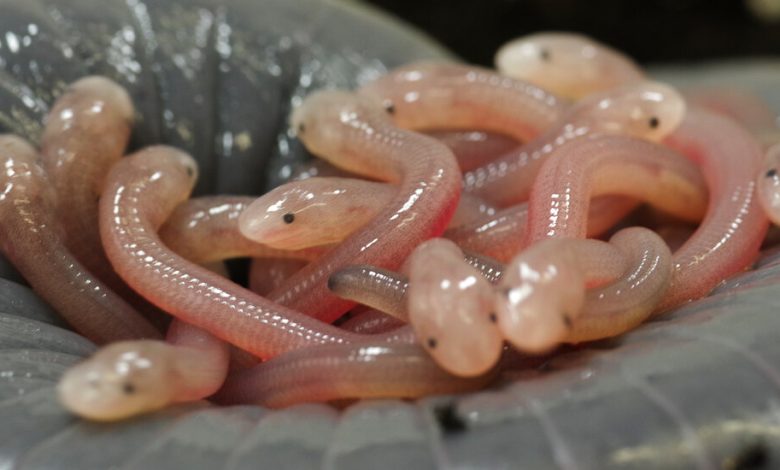These Amphibians Have a Taste for Their Mom’s Skin

When born, baby caecilians — legless amphibians that look like a mash-up of a snake and a worm — use their tiny hook-shaped teeth to scrape off their mother’s skin and feast. The flakes are dead but extra fatty and nutrient-rich, and within three months the infant squirmers have grown into independent teenagers.
The habit offers more than nourishment. According to a study published in May, skin-feeding allows mothers to pass on their unique microbiomes and possibly inoculate their offspring’s immune systems — the first known instance of microbiome transmission among amphibians.
“It’s a remarkably weird thing,” said David Blackburn, the curator of herpetology at the Florida Museum and author of the study. “When you open up their stomachs, guess what: They have skin in their stomach.” He added, “Understanding what are the microbes, where they come from and what are the interactions with disease is really important.”
As amphibians go, caecilians are eccentric: They have no legs, their eyes are minuscule and sometimes covered in skin, and they sense their surroundings with two small tentacles on their faces. Very few amphibians are known to care for their children — most frog and salamander species tend to lay their eggs and leave once they hatch — but caecilians have evolved sophisticated parenting strategies.
Some give birth to fully-formed offspring that have already snacked on the skin in their mother’s oviduct; others watch over their eggs and then donate an outer layer of skin to their newly hatched offspring. It is unclear which of these behaviors evolved first, Dr. Blackburn said, as is the extent to which they help the offspring survive.
For weeks, Dr. Blackburn’s team dug in the tropical rainforest soils of southeastern Cameroon, ultimately collecting 29 skin-feeding caecilians of the species Herpele squalostoma. The researchers analyzed and sequenced 1.5 million sequences of microbial DNA from the skin and guts of the caecilians — six male adults, nine female adults (three of them mothers) and 14 young — and 5,000 microbe DNA sequences from the surrounding environment.
Little of the bacteria found in the offspring matched what was recovered from nearby leaves, water and soil. But in some offspring, as much as 20 percent of their microbiome matched that in their mother’s skin or gut microbe communities.
“For 20 years I thought, ‘It must have something to do with immunity!’” said Carlos Jared, director of the Structural Biology Laboratory at Butantan Institute in Brazil and a renowned chaser of caecilians. He was not involved in this study but has also been investigating the relationship between parenting and microbiome transfer, and was pleased that his two-decade-long hunch had found some confirmation.
“It’s an example of reproductive ecology having consequences for unrelated aspects of biology,” said Mark Wilkinson, an evolutionary biologist at the Natural History Museum in London. In 2006 Dr. Wilkinson published the first description of skin-feeding behavior, and found the skin of caecilian mothers was twice as thick as that of adult females without offspring. “They’re kind of lactating in a way,” he said.
The researchers all emphasized that the findings were very preliminary — based on a small sample size and with many questions unanswered. Are there peak periods when the microbiome of the young is assembled? Does it start growing shortly after birth, or does it accumulate over a lengthy period of caregiving?
Some caecilian species are poisonous, and it’s unclear what happens to the toxins when the skin is consumed by the young. Also unknown is whether this mode of microbe transfer exacerbates the transmission of skin diseases that have been plaguing amphibians and could pose a threat to caecilians.
But learning anything about caecilians is a headache, as they spend most of their time underground, Dr. Blackburn said: “Caecilians have been around for well over 200 million years, but we know exceedingly little about their actual biology.”
As a result, he added, it is hard to know how widely the lessons of caecilians can be applied to amphibians generally.
“Here’s a group of animals that just does things in a fundamentally different way than all the other amphibians, yet they kind of get grouped in with frogs and salamanders,” Dr. Blackburn said. “But it would be like grouping whales in with horses.”



